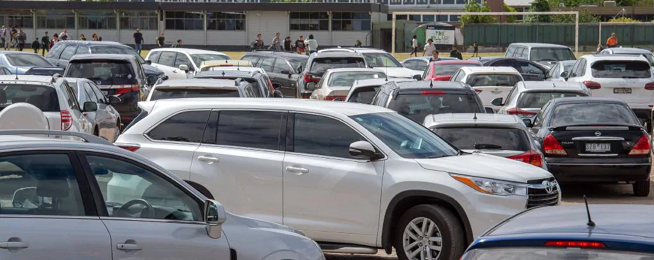The health impacts of the daily school drop-offs and pick-up have become so severe in England that driving children to school could be banned, or severely restricted.
Research is indicating that idling vehicles in school precincts are creating pollution hotspots, with air quality so poor that it is threatening the health of children.
It has been known for years that driving children to school has a negative effect on their health because the trips significantly increased the level of sedentary behaviour.
And children require large amounts of physical activity for healthy development, activity that is denied them if they are driven to school.
But now there is a new focus on the health impacts caused by lingering toxic pollutants from the exhausts of cars idling in the streets around schools.
And the problem goes further: Public Health England is calling for the banning of idling engines in streets around hospitals and care centres.
According to Public Health England medical director, Professor Paul Cosford, idling outside schools should be stopped the community should make sure that children can walk or cycle to school.
The report describes air pollution as the biggest environmental threat to health in the UK and says there is strong evidence that air pollution causes the development of coronary heart disease, stroke, respiratory disease and lung cancer, and exacerbates asthma.
An estimated 28,000 – 36,000 deaths each year are attributable to human-made air pollution in the UK.
UK scientists estimate air pollution cuts British people's lives by an average of six months
The report said that national government policy could support these local actions - for example, they could allow controls on industrial emissions in populated areas to take account of health impacts.
It says more has to be done to make the community aware of the serious impact air pollution ha on the health of children.
The PHE review also recommends:
- Redesigning cities so people aren't so close to highly polluting roads by, for example, designing wider streets or using hedges to screen against pollutants
- Investing more in clean public transport as well as foot and cycle paths
- Encouraging uptake of low emission vehicles by setting more ambitious targets for installing electric car charging points
- Discouraging highly polluting vehicles from entering populated areas with incentives such as low emission or clean air zones
"Transport and urban planners will need to work together with others involved in air pollution to ensure that new initiatives have a positive impact", Prof. Cosford said.

Ride2School is here to help
While Australia may be some time away from putting such an effort to reduce car use at schools, Bicycle Network's Ride2School program is working hard to encourage riding and making it easy for parents to leave the car at home.
More than 900 schools around Australia particpated in National Ride2School Day in March and on average more than 50 per cent of students rode, walked scooted or skated to school.
However, Ride2School is more than just a day and there are plenty of free resources schools can use to make riding easy all year round.
Check out the Ride2School toolbox to start planning bike ed lessons and developing maps and riding routes to your local school. You can also apply for financial grants to use on bike parking, equipment and more.
Ride2School ToolboxBecome our friend
Find out more about Bicycle Network and support us in making it easier for people to ride bikes.


